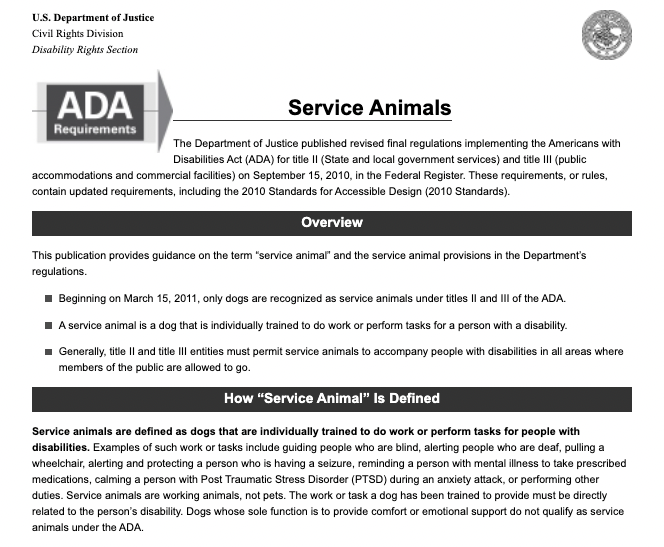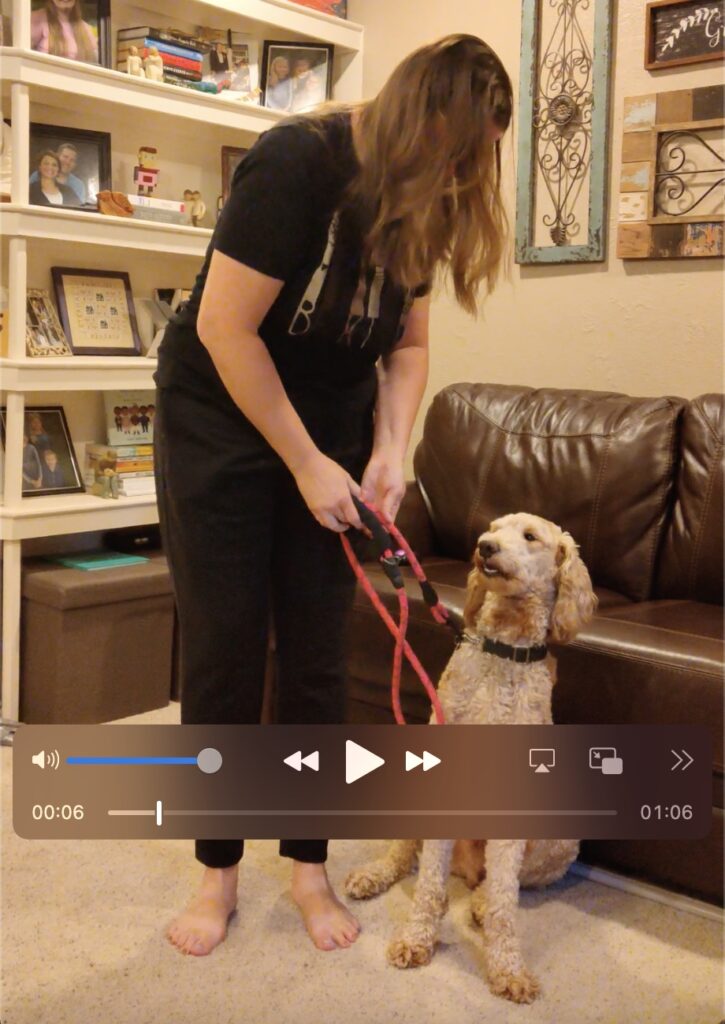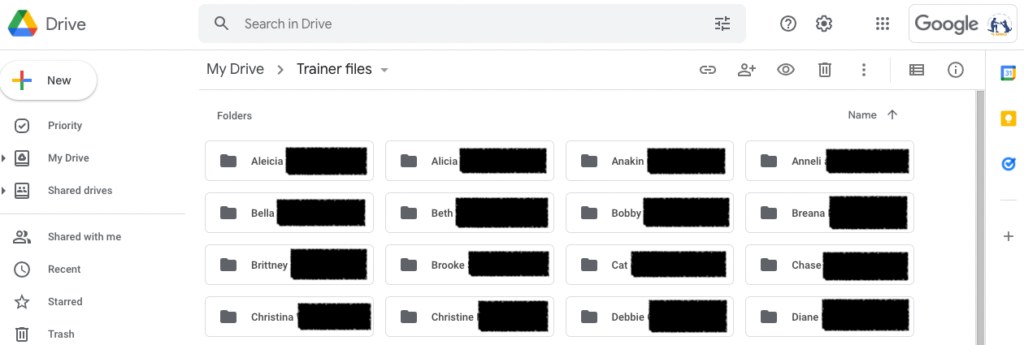by Zan Raynor, certified dog trainer and CEO of ELLAS Animals INC
Documenting owner-training of a service dog serves two equally important purposes. First, it may at some point become necessary to prove that your dog meets the legal requirements to be a service dog and, as an owner/trainer, you will have to provide this as you don’t have the protection of a trainer or a program to do this for you. Second, it can be a valuable tool to make your training more effective, efficient, and comprehensive. There is no standard for how to document owner-training of a service dog, but a combination of approaches can help you cover all the bases and be prepared for anything you might need.
Disclaimer: Nothing in this article is intended as legal advice. It is the opinion of a service dog trainer and meant as education on how and why documenting owner-training of a service dog can be useful. For legal advice, consult a lawyer.
Owner-Training is Legal in the US
The United States is very rare among other countries in the world in that it has legislated (and protected in case law) the right for people with disabilities to train their own service dog and does not require certification or testing of the service dog. In the United States, claiming your disability right to public access with your service dog is quite easy – often referred to as an “honor system” – as covered by the ADA titles II and III and the 2010 Revised Requirements. No one may ask you for more than answers to the “two questions” for public access. However, for work, housing, and airplane travel (as covered by the ADA title I, the FHA, and the ACAA respectively), it can be a bit more complicated and require some documentation. In addition, should an owner/trainer ever find themselves in court (generally because they or someone else filed suit over a denial of their right to public access), the court will undoubtedly require proof that the dog in question legally qualifies as a service dog.

Plan Ahead for Documenting Owner-Training of a Service Dog
To be prepared for these possibilities, it is necessary to plan ahead, regardless of how unlikely you currently think this eventuality could be. At the very beginning of your training journey, you should create a plan for documenting owner-training of a service dog and stick to it throughout the entire process.
To meet the qualifications as a service dog:
- To be protected by the ADA, one must have a disability, which is defined by the ADA as a physical or mental impairment that substantially limits one or more major life activities.
- Service animals are defined as dogs that are individually trained to do work or perform tasks for people with disabilities.
- The work or task a dog has been trained to provide must be directly related to the person’s disability.

In a court, especially given the 2008 Amendments, to prove you have a disability that meets the definition in the ADA is often the easy part. It may be as simple as a doctor’s note or medical records with a diagnosis. That’s not what this article is about.
The more challenging part often is proving that your dog has been individually trained to do work or perform tasks and that these tasks/work are directly related to your disability. Here are the primary forms of training documentation you should create and/or maintain that we’ll discuss at more length:
- Training log
- Corresponding videos of training and achievements
- Certificates of passing tests or courses or achievements or competitions
- List of service dog training resources
Training Log – the Primary Method for Documenting Owner-Training of a Service Dog
There’s no standard form for a training log but it’s widely recognized as the primary evidence of documenting owner-training of a service dog. At a minimum, a log demonstrates the individual training of the dog by enumerating each training session over months or years and the cumulative total training time the dog has received.
The two toughest parts of making a training log are creating/designing it and logging your training in it. For the first of these challenges, do some research on different types of training logs and consider which ones would fit more with your personality and work style. The easier you make this for yourself, the more likely you are to keep up with it. For the second of these challenges, create a routine and don’t deviate from it. Perhaps set an alarm that goes off at the same time every day to remind you to log your training time. Perhaps keep the leash in your hand after a training session until you log your training time. Perhaps put a post-it note on your refrigerator to remind you to log your training time. Some people prefer to log after every formal training session. Personally, I prefer to log once at the end of each day. There’s really no excuse not to log your training. If you can remember to train your dog, and can hold yourself responsible to do so every day, then you can remember to log and hold yourself responsible for doing it every day.
Format
A training log can be digital (kept on a computer or on the internet) or hand-written. I prefer a digital version for several reasons:
- It’s easier to keep on hand than a physical bound journal or three-ring binder. I access my internet-based spreadsheet (I prefer Google sheets for this reason) on my phone, computer, or tablet, so I can fill it in anywhere I happen to be, even in bed at night when I realize I forgot to do it earlier.
- It’s protected online (and I can have several backups if I’m worried about it) so I don’t have to be concerned about losing it or damaging it or destroying it after putting so much time into it over the years.
- I don’t have to worry about filling it up and needing a second or their or fourth book/binder after years of entries.
- It’s easy to share among a training team. Perhaps you have more than one person training the dog. For example, sometimes I do training sessions with my husband’s service dog, and sometimes he does training sessions with his service dog. We both log the dog’s training hours on the same spreadsheet. We each have access to the spreadsheet on our devices. If we tried to share a hard copy, we’d inevitably misplace it or get it dirty or not have it nearby when we needed it.
- It’s easy to share with lawyers, judges, airlines, HR representatives, landlords, etc. without making copies or risking my original.
- It’s easy to keep a running total of the training time so I always know where we stand compared to the minimum standard of 120 training hours. The sum operation in a spreadsheet is a magical thing.
- Digital formats corroborate your entries. Computer experts, with more knowledge than I possess, can check the logged dates against the digital record of when they were made and corroborate that I didn’t just sit down the night before and create a log to turn in as evidence.
Content
A training log can have as little or as much information as you want. Some people prefer journal style entries, with a new page for every training session. They like to write out their daily training experiences in prose. Personally, I find this process deters me from logging every day since it feels like a real task. I prefer the spreadsheet with short answers where I just pop in a few words (and lots of copying/pasting) and even drop-down choices for my common entries. I also think this is more straightforward and easy-to-decipher should I ever need to offer it as evidence. Again, it’s important to choose what will most likely motivate you to keep on top of the daily logging.
At a minimum, you should log the date, the place, and the duration of your training session (e.g. January 24, 2022/living room/15 minutes) as well as what you worked on during that session. Perhaps you log this by command or task or perhaps you describe the skills you were working on or the type of training (foundational obedience, public access, tasks/work). If your service dog has work (something they are aware of or doing all the time rather than just on command), it’s helpful to keep track of this in your training log, too. For example, if a dog is trained to alert to low blood sugar, log every time they do this and whether it was an accurate alert or not. This is valuable documentation of your dog’s successful training of that work, that is hard to demonstrate on command should you ever need to.


As a Training Tool – Not Just Documenting Owner-Training of a Service Dog
Of course, the more you put into it, the more you get out of it. You can create a useful training tool out of your log by including more information that will help you improve your training. You can include a competence scale (like assigning a grade to each training session) and notes about the location, the weather, the distractions, etc. You can include a section for successes and commands/skills that need improvement. Having lots of additional information like this can help you recognize patterns in your training, like your dog doesn’t perform as well in the rain or when the wind is high and blowing leaves around. Perhaps you’ll note that moving from the living room to the backyard usually drops competence for the first few training sessions but then moving to the street doesn’t. This is also a good way to keep track of where you are in the generalization process. You can review your log before a training session to remind yourself that today you want to work on 3 minute duration for the sit-stay but you’re dropping the down-stay to 1 minute because you’re training outside with some distractions.
Training Videos
Videos of you training your dog serve the same dual purpose as the training log. By watching your own videos (like athletes watching game and practice films), you can often identify patterns and things that need to be worked on that you couldn’t see from where you were training or didn’t notice because you were in the moment. Perhaps you’ll notice you always trip over your dog when turning left because they’re too far ahead or you mark “sit” long after the dog’s butt hits the ground. You can often improve your training mechanism and timing just by watching yourself training your dog.

No Need for Perfection When Documenting Owner-Training of a Service Dog
In addition, digital photos/videos are time and date stamped (even if you never see these) so they offer corroborating evidence that supports your training log. It’s important to note that these training videos don’t have to be perfect. In fact, they offer more evidence if you’ve got older videos showing poorer skills and newer videos showing better skills. This is proof of the dog’s training and the results of that training.
Videos of tests or competitions
Remember to get video of your dog achieving the goals, too, though. Any time you take a test/assessment with your dog or participate in a competition, have someone video the test or competition. This serves as excellent proof of individual training because you can obviously see the results. Although it’s just a snapshot in time basically, it still demonstrates clearly that, at least at that point, your dog achieved those standards. This corroborates the certificates you have from passing the test or winning the competition.
Videos of Tasks/Work
One category of videos that owner/trainers often forget is tasks and work. We are so worried about our dog’s public access behavior that we get video of that and we take public access tests to prove that our service dog is trained well enough for this. Notice, however, that the legal requirement for individual training is trained to do tasks or work that directly relate to the handler’s disability. Don’t forget to take video of your service dog training and actively performing their tasks/work and include the command or stimulus to begin, the entire task, and the cessation of the task (how the dog stops doing it, either on command or because the stimulus stopped).
Organization
A logistical point about training videos concerns how to keep them. Rather than have them strewn out among hundreds or thousands of other pictures and videos of birthday parties and days at the beach, take the time to create a folder on the internet where you store all of your service dog videos (iCloud, YouTube, and Google Drive are obvious choices). This way when you need to make them available to someone, you’re not digging through your phone trying to find all of the relevant videos but can just share access to a video or the entire folder.

Certificates of Achievement
One form of documentation that you can submit as proof of your service dog’s individual training are certificates the dog has earned. These may be course completion certificates or passed-the-test certificates. Although classes/lessons and tests are not required, every external verification of your dog’s training and skills adds weight to the growing portfolio of proof. Keep the originals somewhere safe but take pictures and store these online with your videos or your training log so you can access them from anywhere and/or make them available to others as needed. (This is good to do with your vaccination records as well.)

Service Dog Training Resources
Think of this as a bibliography or “works cited” page. Some courts have asked owner/trainers to list/describe their resources for service dog training – in effect, “how did you learn how to train your own service dog?” Create a document or spreadsheet online and keep it in the folder with all of your other documentation. You can list the names of trainers you’ve worked with (and their contact information) and any group classes or private lessons you’ve taken (where and when and even keep the receipts). Be sure to include the curriculum so you can describe what was covered in those classes or lessons. You can list the websites you have used or YouTube videos you have watched, as well as the books you’ve read. This evidence that you have researched, read, watched, and learned, not just winged it, lends more weight to your case that you have the capacity (not just the authorization) to train a service dog.

Documenting Owner-Training of a Service Dog with ELLAS Animals INC
Owner/trainers who work through ELLAS Animals INC’s complete service dog training program build this portfolio of documentation as part of our program. We provide a web-based training log template for them to log their daily training minutes. They won’t fill in every cell in the spreadsheet for every training session, but they pick and choose how much is helpful each time.
They also send in training videos for each lesson, which we save in their file and mark on their Course Completion Tracker. They send in assessment videos at the end of each course, demonstrating their dog can meet all of the requirements at that level. We save these in their file. We present them with certificates of completion for each course/test they pass and we keep these in their file. This includes the final course, Tasks & Work, so they’ve got videos and a certificate that verifies their service dog’s tasks and/or work.
They’ve got their curriculum list so they can easily show what commands/skills have been covered in each course – after reading each lesson, they pass a quiz demonstrating their understanding of the course content which is marked on their Course Completion Tracker. They also have a certified dog trainer who has worked with them and can testify to their training of their dog. By the end of our program, our owner/trainers are confident in their ability to prove that their dog legally qualifies as a service dog because they have been documenting owner-training of a service dog every step of the way.

Nothing in ELLAS Animals INC’s website or blog is intended as medical, legal, or financial advice. We receive no compensation for recommendations or reviews.
